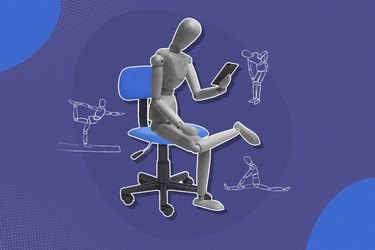
The stability ball is a piece of exercise equipment traditionally used for strength, balance and stability training. But you may have also noticed your coworkers replacing their office chairs with this common workout tool.
Although sitting at your desk for long periods of time can wreak havoc on your posture and overall health, you shouldn't rush to switch to sitting on a stability ball for hours on end either. Before you ditch your desk chair, get familiar with the benefits and drawbacks to sitting on a ball all day — and what you should be doing instead.
Video of the Day
Video of the Day
Drawbacks of Sitting on a Stability Ball All Day
Sitting for long periods at a time has been linked with some negative long-term health effects, including an increased risk of conditions like diabetes, obesity and cardiovascular disease, according to Harvard Health Publishing.
In the short term, sitting for long periods can also increase muscle tightness, particularly in your hip flexors. This can affect your balance, walking gait and overall posture.
But replacing your desk chair with a stability ball isn't the best solution either, says Samuel Chan, physical therapist at Bespoke Treatments in New York.
1. May Cause Aches and Pains
Sitting on a stability ball requires active engagement of the core muscles because you don't have any back support, Chan says. While this position can be good for improving your posture and core stability, as soon as you relax, your posture suffers, which can ultimately lead to aches and pain.
"While you may be mindful enough to keep your core engaged and sit with proper posture on the ball, most individuals inevitably start to slouch over time," Chan says.
Poor posture and lack of back support can cause your lower back to hurt after sitting on an exercise ball, and you may experience wrist or shoulder pain as well, due to the lack of arm rests, he adds.
The same is true when you exercise. An exercise ball can help with back pain if you use it correctly, but it can exacerbate the pain when used incorrectly.
Tip
If you experience lower back pain from sitting on the ball, consider your posture. When you sit on the ball, confirm that your upper body is stacked, with your head centered over your spine and your shoulders directly over your hips. Your hips should be level with — or slightly higher than — your knees, your thighs should run roughly parallel to the floor and your knees should be over your ankles.
2. Can Lead to Muscle Tightness
Plus, you're still in a sitting position, so the risk for issues with hip flexor and hamstring tightness is still there.
If mitigating the health risks of sitting all day is your goal, you'll need to do more than sit on a stability ball for the entire day.
3. Lack of Support
When it comes to an exercise ball versus a desk chair, an ergonomic office chair has supportive features a ball cannot provide, including adjustable seat depth and angle, lumbar support and armrests.
Benefits of Using a Stability Ball
It's not all bad news, though:
1. May Strengthen Your Core
Sitting on an exercise ball can improve your stability and balance, as you must constantly engage the core abdominal muscles to stay upright. A stronger core helps protect the lower back and promote better posture.
2. Might Up Your Calorie Burn
Sitting on a ball may also increase your daily calorie burn by a small amount, according to the University of New Hampshire.
3. Can Improve Your Mobility (When Used Correctly)
And when used during a workout, exercise balls can help improve your stability and mobility, according to the American Council on Exercise. These are two fundamentals of fitness, so establishing a strong foundation can improve your movement patterns for future exercises.
What to Do Instead of Sitting on a Stability Ball All Day
1. Start Slow
If you want to add some core-activating benefits to your work day without adding lower back pain, Chan suggests sitting on the stability ball in intervals, rather than several hours at a time.
"Start out with shorter intervals than you would expect (something like 5 minutes of sitting to start, with much longer rest periods)," Chan says. "Then, slowly build yourself up as your endurance improves."
2. Add Movement
Instead of committing to an eight-hour day of sitting, add some movement into your routine, Chan says. Try setting an alarm or reminder every hour to get up and move, even if it's just a couple steps to refill your water bottle.
3. Work on Your Posture
"My favorite cue for posture is a little post-it or sticky note at the corner of your monitor, or just out of your view to the side," Chan says. "Every time the note catches your eye, you are reminded to re-adjust your posture."
4. Use the Stability Ball for Exercise
Or, if you work at home or in a non-traditional office setting, you can also break up your day with exercises and desk stretches to reap the benefits of the ball.
Unable to pause midday to exercise? Even just incorporating these exercise into your after-work exercise routine can have long-term benefits to your posture and balance.
Warning
If you have a history of back pain, speak to your doctor or physical therapist first about whether stability ball training might help — or aggravate — your condition, and ask them to demonstrate its proper use. If the ball causes pain, find an alternate, pain-free exercise method.
4 Stability Ball Exercises to Try
Rather than sitting on an exercise ball as a desk chair, try to incorporate 8 to 10 reps and 3 sets of these core and back exercises throughout your day:
1. Stability Ball Prone T
- Lay your belly on top of the stability ball, knees bent and arms resting along the sides of the ball. Your knees and toes should be touching the ground and head should rest in a neutral position, looking toward the ground.
- Squeeze your shoulder blades down and back and lift straight arms into a T position with your thumbs pointing up.
- Once your arms are parallel to the ground, pause for a moment then lower back to the starting position.
2. Stability Ball Prone Y
- Start in the same position as the above exercise with the ball under your belly, knees and toes resting on the ground. Allow your arms to lie at your sides, in line with your shoulders.
- Squeeze your shoulder blades down and back and raise straight arms in front of your body and slightly out, forming a Y position. Again, keep your thumbs pointing out.
- Once your arms are parallel to the ground, pause and lower, returning to the starting position.
3. Stability Ball Dead Bug
- Begin lying on the ground with your back flat against the floor.
- Raise your arms straight up toward the ceiling and bring your legs up to tabletop position, bending your knees at 90 degrees so that your shins are parallel to the ground.
- Balance the ball between your palms and knees, just above your midsection.
- Extend your right arm straight over your head and simultaneously extend your left leg straight and away from your body.
- Activate your core to keep the ball balanced between your left arm and right leg.
- Return to the starting position and switch sides, extending your left arm and right leg.
Tip
As you perform this dead bug variation, keep your core activated and lower back flat against the floor.
4. Stability Ball Mountain Climber
- Assume a high plank on the stability ball. Place your palms on the ball and extend your legs out behind you, keeping your body in a straight line from head to hips to heels.
- Activate your core to keep your upper body balanced and back flat.
- Bring your right knee up toward your chest, pause and bring it back to the starting position.
- Then, raise your left knee to chest, pause and return to start.
Tip
As you become stronger, you can increase the pace of your mountain climbers, alternating legs as quickly as possible while maintaining your balance.
Find the Right Size Stability Ball for You
You want to be sure you select a stability ball that fits your height. Choosing a ball that's too big or too small can make sitting or exercising either too difficult or too easy (or in some cases, not possible at all).
Generally, every brand of stability ball will have height and ball size suggestions on their website or directly on the equipment packaging. Or, consider these height/size suggestions from the University of Minnesota Extension when using a stability ball for exercise:
- If you're between 4'7" and 5', your exercise ball should be 18 inches (45 cm) in diameter.
- If you're between 5' and 5'5", your exercise ball should be 22 inches (55 cm) in diameter.
- If you're between 5'5" and 6', your exercise ball should be 26 inches (65 cm) in diameter.
- If you're over 6' to 6'8", your exercise ball should be 30 inches (75 cm) in diameter.
If you're using the exercise ball as a chair, however, the University of Minnesota Extension recommends using a ball one size larger than you would for typical exercise. So, for example, an individual up to 5 feet tall would bump up to a 55 cm exercise ball.
To test whether your exercise ball has you properly aligned at your desk, sit squarely on the ball in front of your desk, close your eyes and face straight forward. Open your eyes. You should be looking right at the center of your computer screen. If you're not, adjust either the screen or where your ball chair is situated.
Next, sit up straight on the ball with your upper arms straight down by your sides. Bend your elbows and place both hands on the computer keyboard or, if you have no keyboard, the desktop. Your elbows should be bent at a 90-degree angle; if they're not, you need to adjust the size of your exercise ball or your desk accordingly.
Is this an emergency? If you are experiencing serious medical symptoms, please see the National Library of Medicine’s list of signs you need emergency medical attention or call 911.

